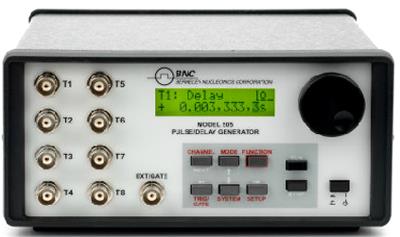
|
|
The BNC 505-8C Eight Channel Pulse Generator has multiple modes of operation and 16 different edges in a single instrument. As a pulse generator it provides rate, delay, width, and output adjustability with each channel. As a digital delay generator, model 505 provides fine resolution, timing, and low jitter.
The outputs are synchronized to one another with coherence of 5 ns. A channel’s timing can be referenced to any other channel or to the zero delay point (To) The edges are adjustable in 100 ns steps. Channels can be selectively gated, enabled / disabled. Each channel possesses separate output level and polarity characteristics along with system level gating capability. Model 505 provides the ability to store custom parameter settings which are able to be recalled for later use.
Specifications.
Electrical Outputs: 8.
TIMING DELAYS AND WIDTHS.
Delay: 0 to 1000 seconds with 100 ns resolution.
Width: 100 ns to 1000 seconds with 10 ns resolution.
Accuracy: 10 ns + .0001 delay.
Time base: 50 MHz, 50 ppm crystal oscillator.
RMS jitter: < 2 ns.
EXTERNAL TRIGGER/GATE.
Rate: 0 to 2 MHz.
Insertion delay: < 250 ns.
Threshold: 200 mV - 15V.
Trigger slope: Rising or falling edge, selectable.
Gate: Active low or active high, selectable.
Impedance: 1000 ohms.
INTERNAL REP RATE GENERATOR.
Rate: 0.001 Hz to 2 MHz.
Accuracy: 5 ns + 0.0001 x period.
RMS jitter: < 500 ps.
OUTPUTS: Adjustable to 20 V.
IMPEDANCE: 50 ohm.
ADJUSTABLE AMPLITUDE.
Slew rate: > 0.2 V/ns.
Amplitude: 1V - 10V into 50 ohm load, 2 V - 20 V into high impedance.
Peak current: 150 mA per channel.
Average current: 200 mA average (total for all channels).
Polarity: Positive (active high) or Negative (low).
COMPUTER INTERFACE.
RS232: 4800, 9600, 19200 & 38400.
IEEE 4888: Standard.
|